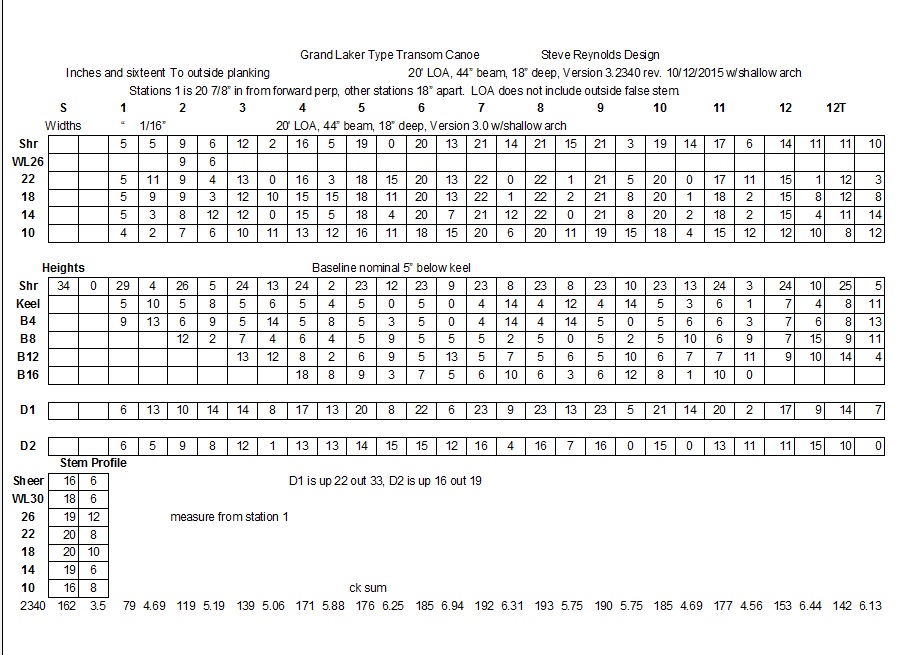How to Draw Lines Plan From Table of Half Breadths
Lofting has two chief objectives. The drawings stand for the shape of the boat full size and so can be used to make templates for parts. Secondly, the drawings permit the builder to confirm that the shape of the gunkhole will be fair, that is, without lumps and bumps. At that place are three views of the boat produced when lofting : the body plan, which is the gunkhole viewed from directly ahead or astern; the profile programme, which is the boat seen from the side; and the half-latitude program, which is the gunkhole viewed from overhead. The image above is an example of a body plan. The curved lines show the shape of the hull at specific 'stations' spaced at regular intervals along the length of the boat. Unremarkably, the stations frontwards of the middle of the boat are on one side and the aft stations are on the other side in the drawing. One of the main uses of a trunk plan is to make the forms that the gunkhole is built on.

A table of offsets is the key to edifice a boat. Information technology gives measurements to points which, when continued in a smooth bend, stand for the shape of the gunkhole at all the stations and in all three views. The tabular array of offsets above is for my 1000 laker canoe design, which too is shown in the torso programme above. At that place are 12 stations plus measurements for the S(tem) and vertical project of the T(ransom). Station 1 is 20-7/8″ back from the forward face of the stem, all others are spaced eighteen″ autonomously. The measurements are in inches and sixteenths of an inch.
The starting time prepare of numbers titled 'Widths' shows measurements to points horizontally out from a centerline at unlike 'waterlines'. Waterlines are horizontal slices through the hull at different heights above a baseline. The choice of waterlines is arbitrary but can brand things easier or harder depending. In my design, I elected to institute a baseline about 5″ beneath and parallel to the mid-section of the intended keel, and draw waterlines parallel to the baseline starting ten″ above the baseline and and then every 4″.
The second set of numbers titled 'Heights' shows measurements vertically up from the baseline at different 'buttocks'. Buttocks are vertical slices through the hull parallel to the centerline at unlike distances out from the centerline. Once again, the choice of buttocks is arbitrary, and I chose to draw buttocks every 4″.
The Diagonals D1 and D2 are a third set of measurements to check the fairness of the hull. Their placement is selected in an attempt to have the diagonal lines cross the station lines at close to right angles, and they are defined every bit being 'X' inches upwardly from the baseline and 'Y' inches out from the centerline. The measurements are from the end of the diagonal on the centerline to the point at the desired station.
To begin a trunk plan drawing, a suitable surface is prepared – i/4″ plywood with a glaze of flat white primer is good – and for my boat, a piece about 42″ tall by 48″ broad is sufficient to draw the stations full size. The centerline, waterlines and buttock lines are drawn in and labeled and and so y'all tin can begin marking the points for each station from the Widths, Heights and Diagonals. In the example beneath, looking at Station 3, we run into that at waterline 18, the measurement from the centerline out is 12-10/16″ or, 12-5/viii″. Station three height at buttock iv is 5-fourteen/16″, or 5-seven/8″. Besides, the measurement for diagonal 1 is fourteen-ane/2″ and diagonal 2 is 12-1/16″.

Transferring these to the trunk plan, we get the points circled below. Afterwards all the points for a station are drawn, the points must be continued in a smooth bend, and this is done with flexible battens of diverse material – I use wooden ones in unlike sizes and you have to get artistic nearly belongings things in place while you describe the lines.

When you have finished drawing all the stations yous have something – fifty-fifty if but a prissy drawing to put on the wall. I will discuss the contour and one-half-latitude views in another blog.
Source: https://www.stevereynoldsinstruments.com/blog/?p=922
0 Response to "How to Draw Lines Plan From Table of Half Breadths"
Post a Comment